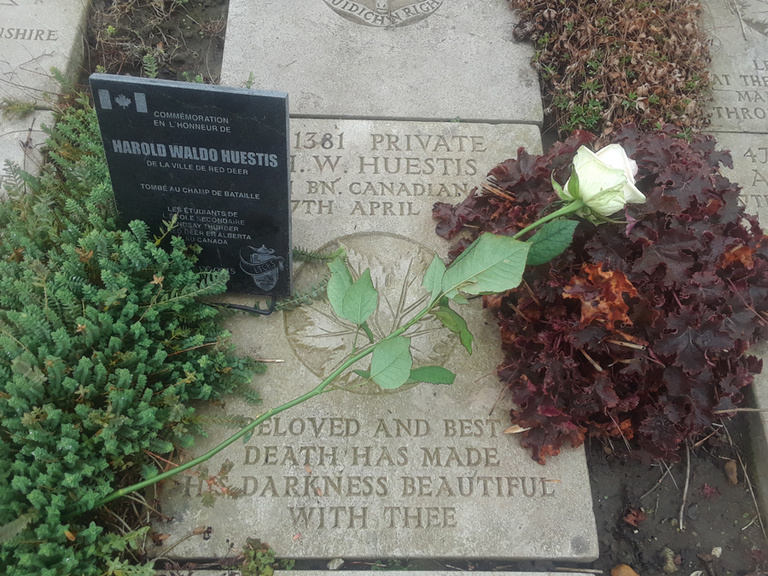
Waldo's grave, and the marker left behind by his school in 2015
I hadn’t planned on writing this post. I want to write about what a wonderful time I’m having here in Germany, and while I wouldn’t trade my travels last weekend for anything, 'wonderful' is not the word to describe them. I had planned on this weekend being a private experience. I changed my mind, however, when staff from the IES headquarters in Chicago came by to speak with the students on our experiences here in Freiburg. During this visit, a staffer asked about independent travel. I mentioned I had gone to Verdun over the weekend. “Where’s that? Is it known for anything?” They asked.
Yes, yes it is.
Boulogne Sur Mer
Visiting Verdun was not the primary purpose of my travels over the weekend. Instead, I was doing something I had planned since I knew I would be studying in Europe. I was going out to find Harold Waldo Huestis. Waldo, as he went by, was from the town of Red Deer, Alberta, and was the best friend of my great-grandfather, Edward William Scott Kane. When World War I came Waldo, who had previously been working as a teacher, enlisted and went off to Europe in March of 1916. He wrote to Edward throughout this experience--working around wartime censorship to describe his experience crossing the ‘necessary channel’ to get to Europe, sending a Christmas card back to Canada, and on one occasion sending a picture of himself in uniform (and here I must thank UI conservator Giselle Simón for her input on preserving these materials).
In March of 1917, Waldo was injured not far from Vimy Ridge, losing a leg as a result. There are no letters from him after this point; all I know of what happened next comes from contemporary reports in the Red Deer press and family history. In the hospital, he was visited by his brother Ralph, the first time they had seen one another since the start of the war. Shortly afterward, he succumbed to his wounds, a victim of ‘early medicine’ was how Edward had put it. He was buried in the Commonwealth cemetery in Boulogne.
Edward never went to war. He was in training to become a pilot when the war ended. Instead, he went to school and became a lawyer. When World War II came, he attempted to enlist but was turned down because of his age. In the sixties, he did go to France, to Boulogne Sur Mer. After nearly half a century of waiting he was able to pay his respects to his friend.
And fifty years later I was repeating the voyage to Boulogne Sur Mer. I don’t know why exactly; Edward died before I was born. Everything I know of him and Waldo comes from my mother and grandmother. I guess, somehow or another, the story stuck with me.
When I arrived in Boulogne, I made the half hour walk from the train station to the Commonwealth cemetery. Along the way I passed a flower shop and, though I had not planned on it, I purchased a rose to leave at Waldo’s grave. The cemetery is long and narrow, the headstones lying flat upon the ground, apparently due to the coastal soil. It was quiet at the time of my visit, though there were signs around of earlier visitors. Flowers, flags, on one occasion a photograph, all sat upon the graves.
While I knew the general area where Waldo was buried, I had trouble finding his grave. The only thing to easily distinguish many of the graves were the national markers, but Vimy Ridge took many Canadians at the same time, so the presence of a maple leaf upon a tombstone did nothing to help me find him. At one point, I thought I had come across another picture, one that had fallen over. I picked it up, only to discover it wasn’t a picture. It was a marker left behind in 2015 by students from a high school in Red Deer commemorating one of their own; Harold Waldo Huestis. I carefully put the marker back and placed the rose beside it. After about half an hour alone by the grave, I left the cemetery to continue my travel.
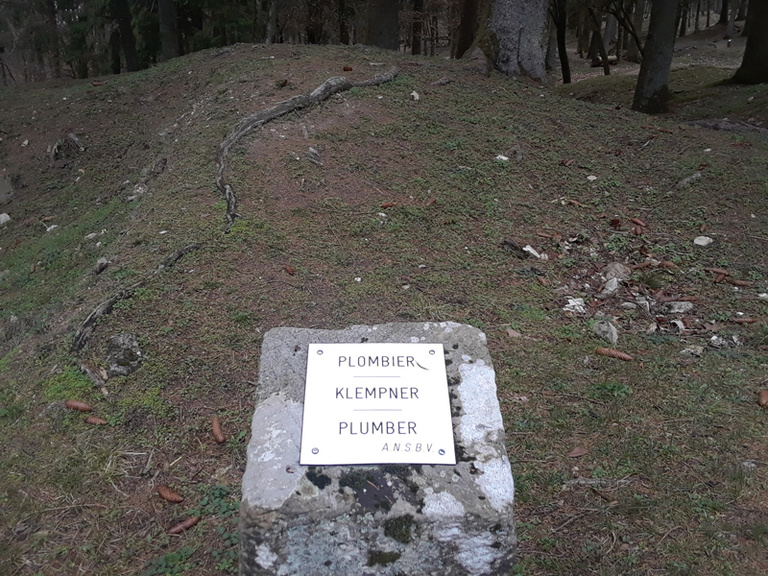
Once the location of Fleury-devant-Douaumont, a village destroyed in the battle
Vimy Ridge
The Battle of Vimy Ridge, in Canadian culture, occupies a place comparable to Gettysburg in American culture. Even if it wasn’t the event that was ultimately responsible for Waldo’s death, I would have known about it simply by virtue of having spent several years living in Canada. I had already known the battle killed more people in twenty-four hours than any other event in Canadian history. I could already recognize the memorial having seen it countless times before on the Canadian twenty-dollar bill. Despite this, I had almost no idea what happened at the battle before my visit to the ridge.
What happened was the Germans controlled Vimy Ridge. All the collected military divisions of Canada launched an attack, and the Germans fell back to a position a few miles away. It was irrelevant to the broader course of the war. A world in which the battle was never fought, and the thousands, like Waldo never died is a world in which World War I ends the exact same way on November 11th, 1918. The reason I had not heard more about the battle was that there wasn’t a great deal more to learn. The importance of Vimy Ridge in Canadian culture isn’t so much what was accomplished there as it is the role it played in the formation of the development of Canadian national identity. It was the first time the Canadian army fought together as one. Vimy Ridge was adopted as a symbol of Canada being able to stand on its own, even at a significant cost.
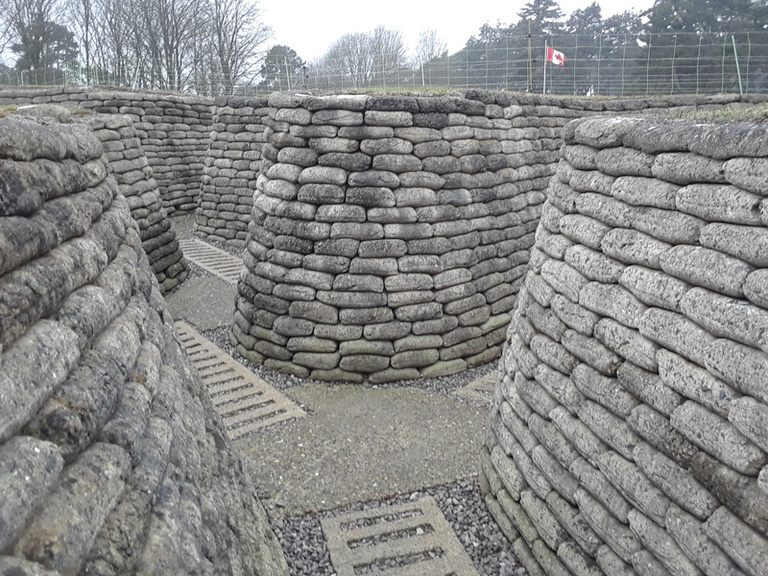
A trench preserved in stone at Vimy Ridge
Walking the path laid out through no man’s land, I was struck by what the battle had done to the ridge, even a century later. Vimy Ridge is at the heart of what the French government declared “Zone Rouge” after the war, land that was too dangerous ever to be used again. The effects of the battle were visible all around me. The ground was pocked with marks where shells had exploded. There was electric fencing running alongside the paths, in part to protect visitors from the unexploded shells which lie under the earth. A forest has grown around much of the ridge in the absence of anyone tending the land. One of the sights that struck me the most was a sign warning visitors of the risk of unexploded bombs right next to the wall of a cemetery. The image of sacred ground and cursed ground sitting side by side is something I would have never anticipated before the visit.
The monument which now sits atop the ridge is not one of triumph, but instead one of mourning. Around the base are the names of eleven thousand Canadian victims of the war whose bodies were never found or identified; the monument stands as the only memorial available to all the families and friends who lacked the small consolation my great-grandfather had in at least being able to visit the grave of his friend. Beyond the names are statues intended as personifications of, among others, Justice, Knowledge, Hope, and Canada, itself. All are in deep mourning. I can’t think of another memorial I’ve seen- in Europe or North America--which goes to such lengths to emphasize the tragedy experienced at the place it is commemorating.
Verdun
Unlike, Vimy Ridge I have no family connection with Verdun. Instead, it sits along the route back to Freiburg and, being a significant point in the history of the war, I decided I should visit it as well in the hopes of bettering my understanding of what happened in World War I. When I first arrived in Verdun, it was immediately clear the handling of events was different from that at Vimy Ridge. Walking through the center of town I passed the “Monument to Victory” A hundred-foot stone pyramid, at the top of which is a statue of Charlemagne holding a sword. Similar, smaller monuments stood throughout the town; celebrating angels, soldiers illuminated in the colors of the French flag, a single massive ‘V’ for victory and for Verdun. Given that the outcome of Verdun was significant to the war in a way Vimy Ridge was not, I had no idea what I might expect at the battlefield.
As it turns out, the battlefield, a place larger than Iowa City, was utterly unlike the city. Part of this was for practical reasons; like Vimy Ridge it was part of the Zone Rouge and mostly left to nature. Part of it was that the place was, and still is, an enormous cemetery. More than three hundred thousand people died over nine months at Verdun. To this day, remains are still being found in the area. All remembrance of the war to be found at the battlefield is conducted with this reality in mind.
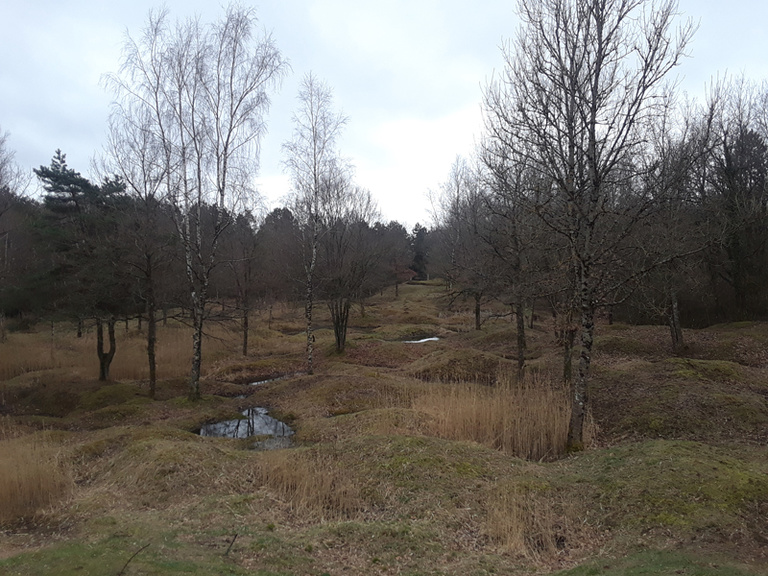
The Battle of Verdun continues to scar the land to this day
I started at the Douaumont Cemetery. Declared a national cemetery of France, the graves here stretch off seemingly forever. Atop the hill is the Ossuary containing the remains of hundreds of thousands of unidentifiable French and German soldiers, who, having fought in life, are together in death.
From the cemetery, I took a path through the much larger no man's land. Occasionally, I saw the remains of trenches, still stretching off into the distance; pillboxes with graves atop, presumably for those still within, and twisted metal wreckage, left untouched for a century. However, for much of the area, there is no sign of the catastrophe that took place. The woods that have grown up like a shroud, for the most part concealing the devastation that had marked the land. It was a very quiet walk. Tourist season in Verdun is in the summer, and this was Mardi Gras weekend meaning almost no one else had reason to come to the area. As a result, I had seemingly the entire battlefield to myself. I spent much of my time that day walking through the woods and ruins, listening to birdsong and contemplating what had taken place a century earlier.
Several villages were destroyed in the battle, road signs still stand marking their location. Venturing further in there are signs telling what once stood at that location: a farm, a bakery, the town hall. It was when I was walking through one of these lost villages towards the end of the day my phone buzzed. My grandmother wanted to know how I was doing. I hadn’t planned on contacting my family until I was back on the train to Freiburg, but at the moment the weight of what I had seen that day caught up with me and I almost started to cry. The relief at being able to talk to my family, and be reminded that the rest of the world was so great, that I ended up messaging them throughout the rest of the day.
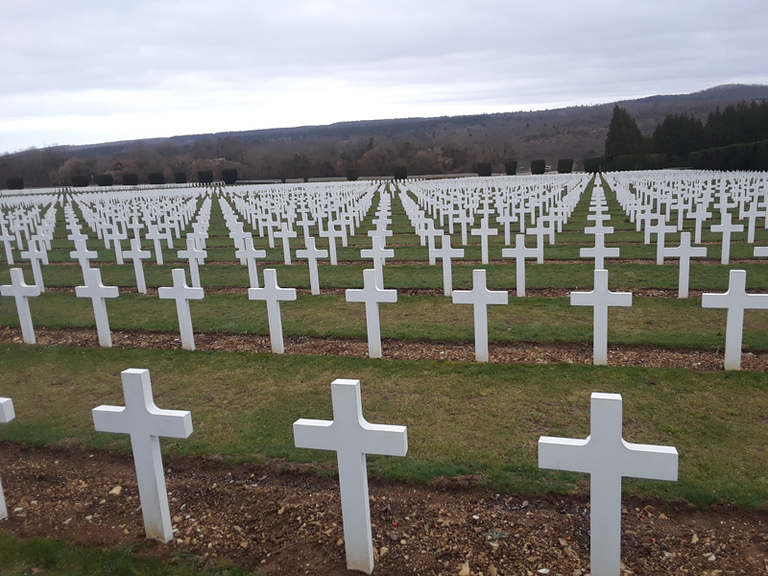
Douaumont National Cemetery, Verdun, France. More than a quarter of a million died at Verdun.
Freiburg
I don’t blame the staffer for not knowing about Verdun. Despite the deaths of over one hundred thousand Americans, World War I has not made the same impression in the United States as it has in Europe or the Commonwealth nations. For the most part it’s taught in a passing way; an Archduke was shot, and the war started; an ocean liner was sunk, and the United States entered; the peace was botched, and World War II resulted; also the Red Baron was in there somewhere. This is a standard understanding of the war in the United States, and I don’t blame a staffer who works on the business side of the program for not knowing more.
But at the same time, the conversation disturbed me. The loss my great-grandfather felt over his friend was something that stayed with him his entire life. This was a loss that was repeated and amplified millions of times over all around the world. What would eventually become the European Union was created in an effort to stop this process of loss, destruction, and pain after it had repeated itself twice in twenty years. If this loss can be forgotten and ignored so completely, even by someone whose work takes them to the place all of this pain was felt, what else is being forgotten and ignored? What am I forgetting or ignoring?
I guess that is why I went to find Harold Waldo Huestis in the first place. Not only to remember my great-grandfather's friend, but to remember to remember.

A native of Rolfe, Iowa, Lee Sailor is a political science major and pursing a minor in history at the University of Iowa. Lee is spending the semester in Germany on the IEW Freiburg European Union program.